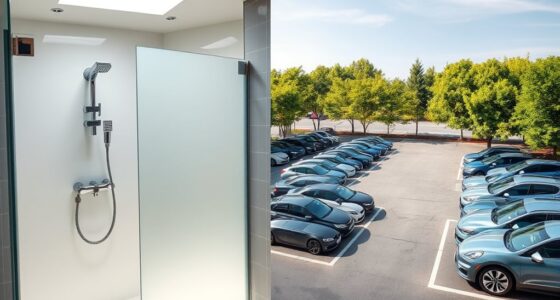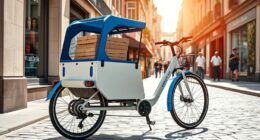To navigate city streets like a pro, pick the right bike for your needs and always check it before you ride. Carry your essentials in a daypack or on a rear rack to keep things manageable. Stay visible with bright clothing and lights, and follow traffic laws to ride predictably. Keep an eye out for hazards and be courteous to other road users. Stick around for more tips on maximizing your urban cycling experience!
Key Takeaways
- Choose a bike suited for city terrain, ensuring it’s well-maintained with a pre-ride check for safety and performance.
- Wear bright clothing and use lights to enhance visibility, especially during low-light conditions or night rides.
- Follow traffic laws and signal your movements to communicate clearly with other road users, maintaining predictable behavior.
- Utilize a daypack or front basket for efficient carrying of essentials, making short trips more manageable.
- Invest in a heavy-duty U-lock and park indoors when possible to secure your bike against theft.
Choosing a Bike
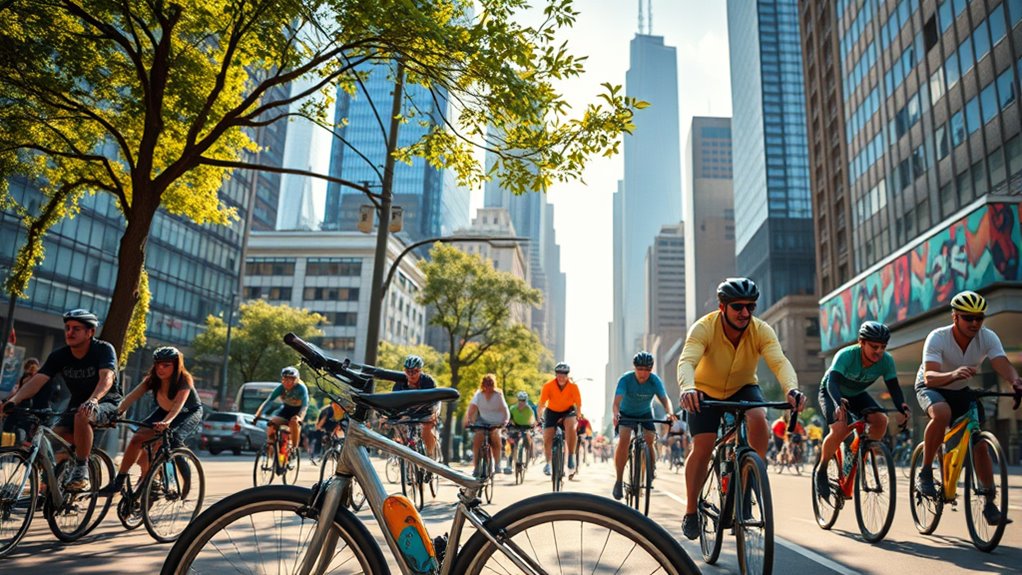
When you’re choosing a bike for urban cycling, what matters most is matching it to your personal preferences and the riding conditions you’ll face. Road, mountain, or hybrid bikes can all work, depending on your style and the terrain.
If you anticipate rainy days, adding bike fenders is a smart move to keep you dry and comfortable. Before hitting the road, familiarize yourself with the bike parts, especially if you’re using city-provided bikes. This guarantees safety and proper handling.
Don’t forget about regular maintenance, too—it keeps your bike in top shape and extends its lifespan. If you’re just looking for short trips, consider bike-share programs or rentals for flexibility without the commitment of ownership. Additionally, incorporating natural elements into your cycling gear can enhance your overall experience and comfort.
Carrying Stuff
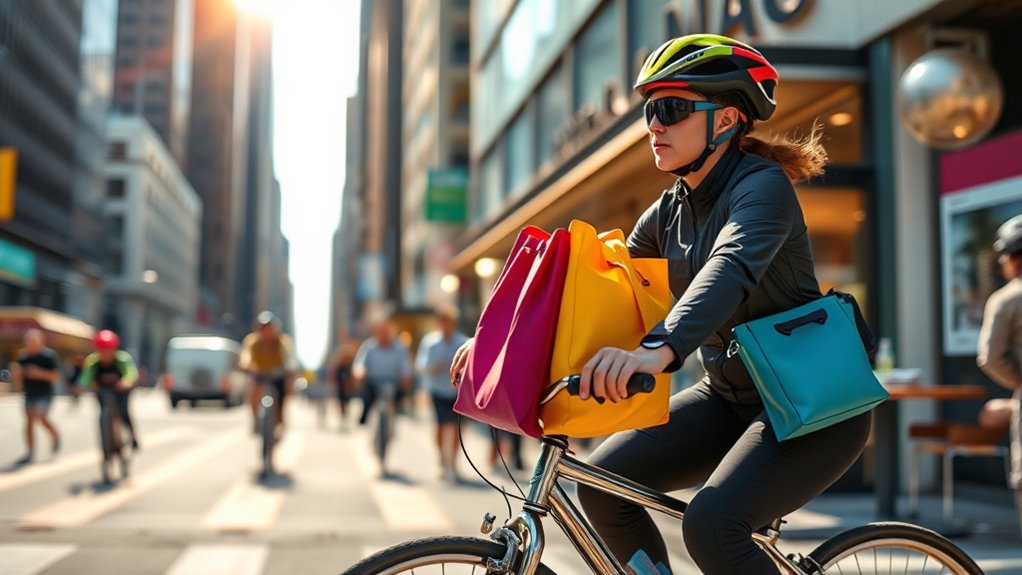
Carrying your essentials while cycling through the city can be a breeze with the right gear. For short trips, a daypack or messenger bag suits you perfectly, offering convenience without bulk.
If you need more space, consider adding a front basket to your bike; it not only increases your carrying capacity but also enhances its look.
For longer distances or heavier loads, opt for a rear rack with panniers or a basket to keep everything stable and efficient.
If you’re hauling substantial items or groceries, a cargo trailer can greatly expand your capabilities.
To find the best fit for your needs, consult dedicated resources like the REI Expert Advice article, which breaks down the pros and cons of each option. Additionally, portable camping toilets can be a great solution for those on longer rides who may need restroom access while out and about.
Bike Security
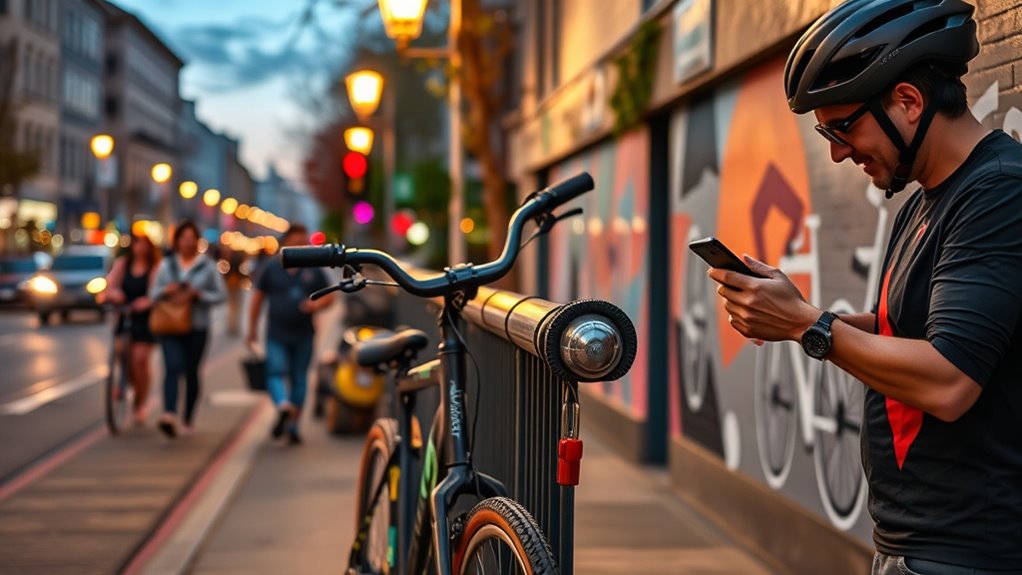
Securing your bike is essential, especially in urban environments where theft can be a real concern.
Invest in a heavy-duty U-lock for longer stops, as it offers better protection than lighter cable locks, which are best for quick stops.
Always park your bike inside workplaces or stores when you can; keeping it out of sight considerably reduces the chance of theft.
Park your bike indoors whenever possible; out of sight means a lower risk of theft.
If you’re attending events, use secure bike parking services whenever available.
Opt for bikes with low curbside appeal in high-crime areas to deter thieves.
Also, secure accessories with bolted clamps and remove any valuables, like bags or electronics, before leaving your bike unattended.
Additionally, consider using high-quality security measures to further enhance your bike’s safety against theft.
These simple steps can help keep your ride safe and sound.
Bike Clothes
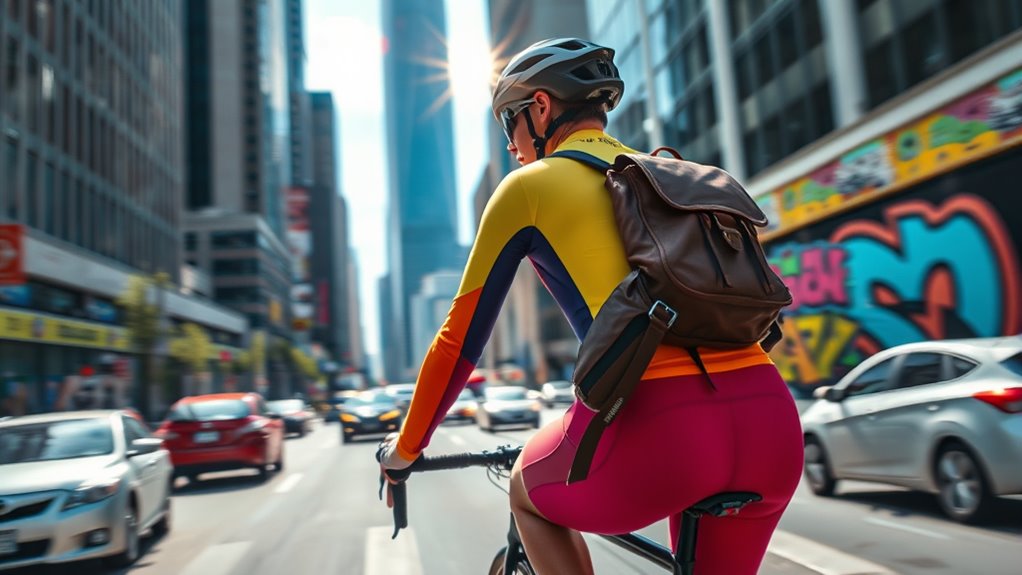
When you’re cycling around the city, you don’t need special gear—regular clothes often do the trick. However, consider weather-appropriate gear like windbreakers to stay comfortable and safe. Also, keep your attire practical by avoiding long scarves and securing your pant legs to prevent any mishaps. To truly embrace the joy of riding, it’s essential to incorporate cycling meets style into your wardrobe.
Essential Cycling Attire
What should you wear for urban cycling? While specialized bike clothing isn’t a must, padded shorts can greatly enhance your comfort on longer rides. Avoid long scarves and billowy garments that could get caught in your bike’s mechanics. Rolling up or securing your pant legs is essential to keep them clear of the bike chain. A wind and waterproof jacket is recommended to protect you from unexpected weather while commuting. Bright clothing is vital for visibility, especially in low-light conditions. Additionally, investing in practical advice for cyclists can help you choose the right gear for your rides.
| Clothing Item | Purpose |
|---|---|
| Padded Shorts | Comfort on long rides |
| Windproof Jacket | Protection from weather |
| Bright Clothing | Enhanced visibility |
Weather-Appropriate Gear
Choosing the right gear for varying weather conditions can make a significant difference in your urban cycling experience.
While special bike clothing isn’t essential, padded shorts can enhance comfort during longer rides, especially on commutes.
When the weather turns, opt for windproof or waterproof jackets to stay dry and warm, ensuring you remain comfortable throughout your ride.
Avoid long scarves and loose garments that can get caught in bike mechanics; instead, prioritize fitted clothing for safety.
Rolling up or securing your pant legs prevents entanglement with the bike chain, reducing accident risk.
Finally, wearing bright, reflective clothing boosts your visibility to other road users, making your rides safer day or night. Additionally, regular quality time spent cycling with friends or loved ones can strengthen your connections and enhance your overall riding experience.
Safety and Comfort
To verify your safety and comfort while cycling in the city, it’s crucial to select appropriate clothing that complements your ride. While specialized bike clothing isn’t necessary, padded shorts can enhance comfort on longer journeys. Avoid long scarves and loose garments that might get caught in your bike’s mechanics.
Securing your pant legs helps prevent entanglement with the chain, making your ride safer. Wind or waterproof jackets shield you against bad weather, while bright clothing greatly improves your visibility to other road users. Additionally, considering financial aid sources for purchasing specialized gear can enhance your cycling experience without straining your budget.
| Clothing Item | Purpose | Tips |
|---|---|---|
| Padded Shorts | Enhance comfort | Great for long rides |
| Windproof Jacket | Protect against weather | Choose breathable fabric |
| Bright Accessories | Improve visibility | Opt for reflective materials |
| Secured Pant Legs | Prevent entanglement | Use clips or bands |
| Regular Clothes | Everyday cycling | Verify a snug fit |
Riding Safety
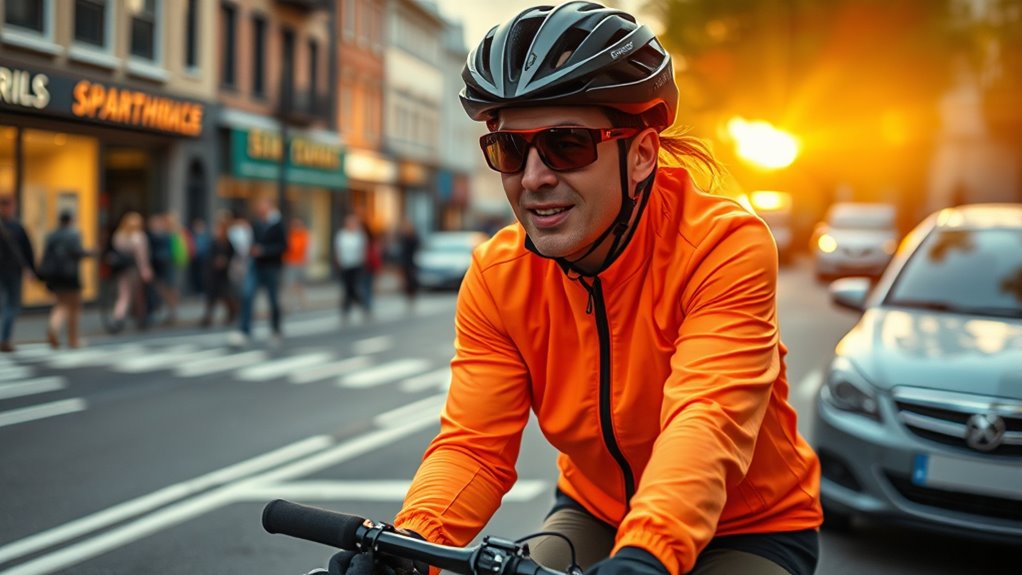
When you’re out cycling, staying visible is key, so wear bright clothing and use lights, especially at night.
Following traffic laws and signaling your movements keeps you predictable and safe on the road.
Always keep an eye on your surroundings to avoid hazards and maintain a safe distance from vehicles. Additionally, consider using a high-quality HEPA filter mask to protect your lungs from urban air pollution while riding.
Visibility and Clothing
Visibility is essential for safe urban cycling, especially in low-light conditions. Wearing bright, reflective clothing greatly boosts your visibility, making you more noticeable to drivers and pedestrians.
To enhance this further, incorporate front and rear lights on your bike; studies show that using lights can increase visibility by up to 90% at night.
Be mindful of your clothing too. Avoid long scarves and loose fabric to prevent entanglement with bike mechanics, which is vital for maintaining control.
Padded shorts can improve comfort during longer rides, helping you stay focused on the road.
Finally, roll up your pant legs to keep them clear of the bike chain, ensuring safety while keeping your clothes clean and damage-free. Additionally, consider wearing high visibility colors to further enhance your presence on the road.
Traffic Law Compliance
Staying safe while cycling in urban areas goes beyond visibility and clothing; understanding and following traffic laws is equally important.
Always ride with traffic and use designated bike lanes whenever possible to comply with local regulations and enhance your safety. Clearly signal your turns and lane changes to communicate your intentions, reducing the risk of accidents.
Familiarize yourself with local cycling laws, which may include restrictions on riding on sidewalks or requirements for using lights after dark. Obey all traffic signals and stop signs, as you’re subject to the same rules as other vehicles.
Finally, yield to pedestrians in crosswalks and be courteous to fellow road users, promoting a safer and more harmonious cycling environment. Additionally, consider establishing an emergency fund to help address unexpected expenses related to cycling, such as repairs or medical costs resulting from accidents.
Predictable Riding Behavior
To guarantee your safety while cycling in urban areas, predictable riding behavior is essential. When you ride predictably, you make it easier for others to anticipate your actions.
Here are some key practices to adopt:
- Signal your turns and stops clearly to communicate your intentions to drivers and other cyclists.
- Maintain a straight line while riding and avoid sudden movements to reduce collision risks.
- Keep a steady speed and avoid weaving in and out of traffic, as erratic behavior can confuse drivers.
- Ride in the same direction as traffic, using designated bike lanes when available, to enhance your visibility and safety.
Pre-Ride Bike Check
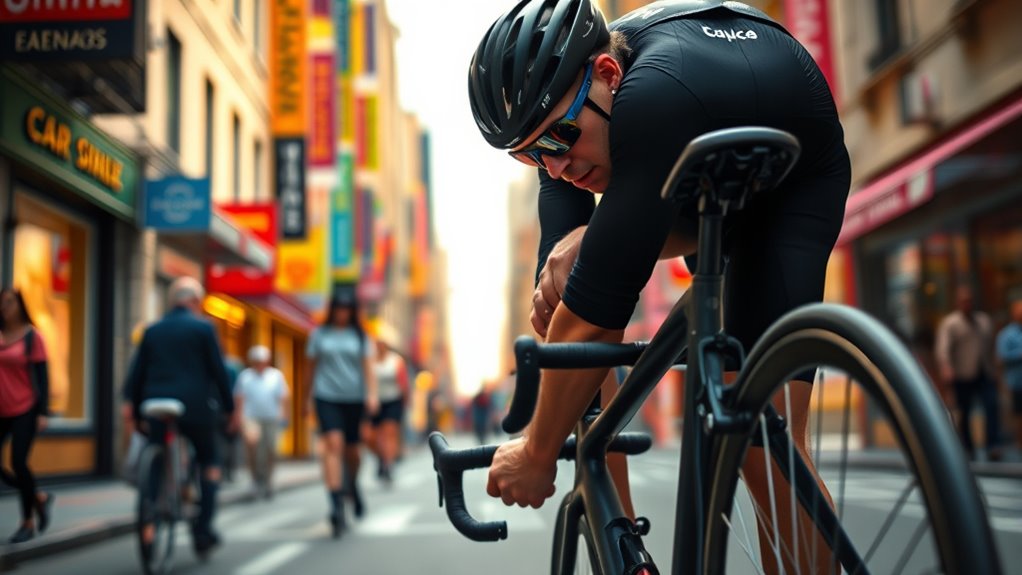
Before you hit the pavement, a quick pre-ride bike check can make all the difference in your cycling experience.
Start by inspecting your tires for proper inflation and tread condition; this guarantees safety and performance on city streets.
Next, adjust your saddle height so there’s a slight bend in your knee when the pedal is at its lowest point, allowing for maximum pedaling efficiency.
Don’t forget to test your brakes to confirm they engage properly—effective braking is essential in urban environments.
If you’re using a city-provided bike, familiarize yourself with its features, like gear shifts and brake mechanisms.
Finally, conduct a visual check of your bike’s frame and components for any signs of wear or damage before you ride.
Navigating Bike Paths
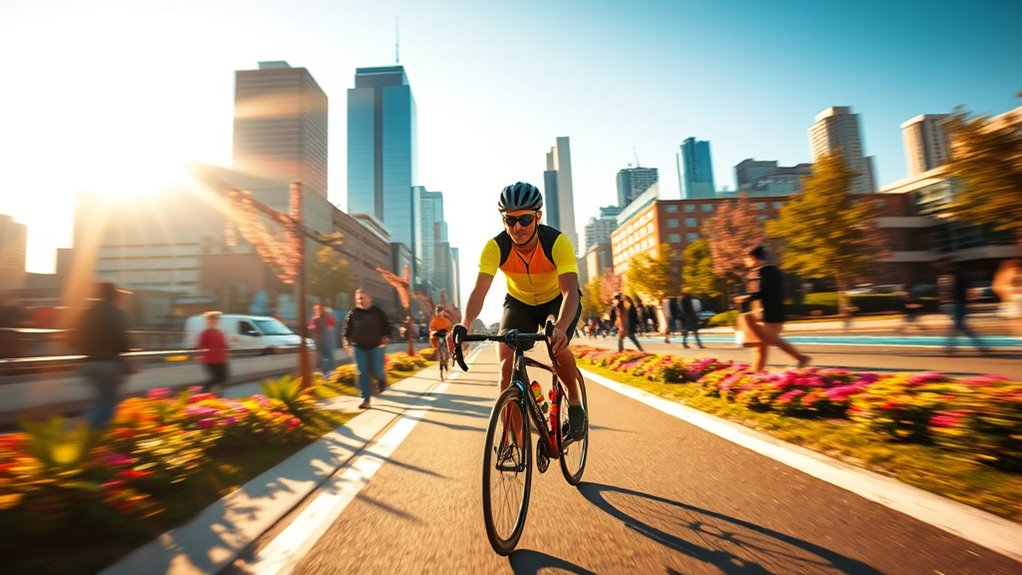
Now that your bike is ready for the ride, traversing bike paths becomes your next focus. To navigate these paths like a pro, keep these tips in mind:
With your bike prepped, mastering bike paths is essential—follow these tips for a safe and enjoyable ride.
- Look for signage: Clear indicators help you find bike paths and understand local rules.
- Maintain a gentle speed: This keeps you and others safe, especially on shared paths with pedestrians.
- Stay aware: Keep an eye out for intersections and areas where bike paths meet roadways to avoid collisions.
- Be courteous: Treat bike paths as shared spaces; yield to pedestrians and practice patience to guarantee a harmonious environment.
Riding Strategy and Safety
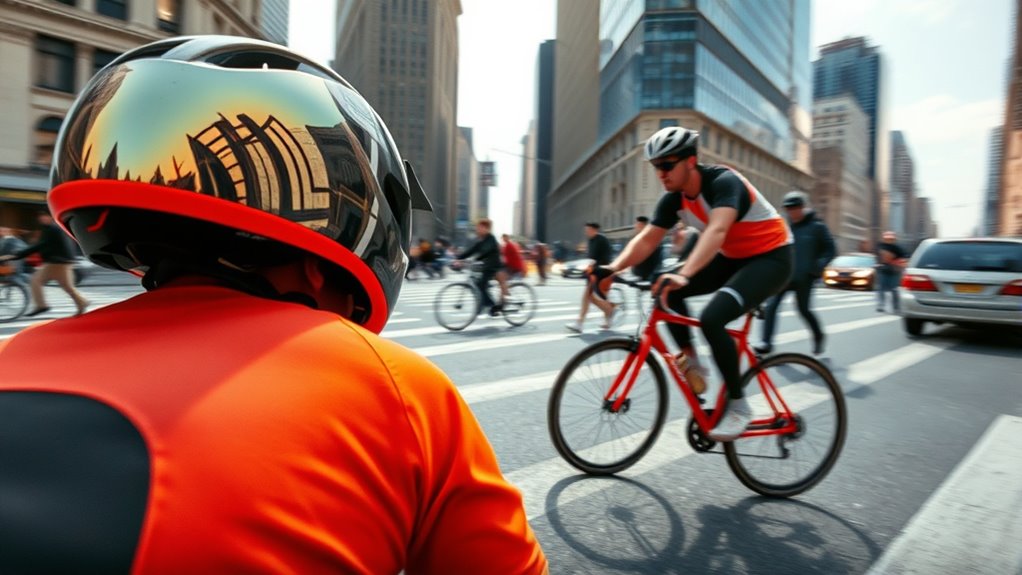
While traversing urban landscapes on two wheels, having a solid riding strategy is essential for both safety and efficiency.
Start by planning your cycling routes in advance to minimize distractions and guarantee a smoother ride, especially in busy areas. Try to ride during off-peak hours when traffic is lighter—this can greatly reduce stress and hazards.
Always wear a helmet; it’s your best defense against serious injury. When you’re on the road, clearly signal your intentions using hand signals, fostering better communication with other road users.
Maintain a safe distance from vehicles and obstacles, positioning yourself effectively to navigate potential hazards.
Road Awareness and Courtesy
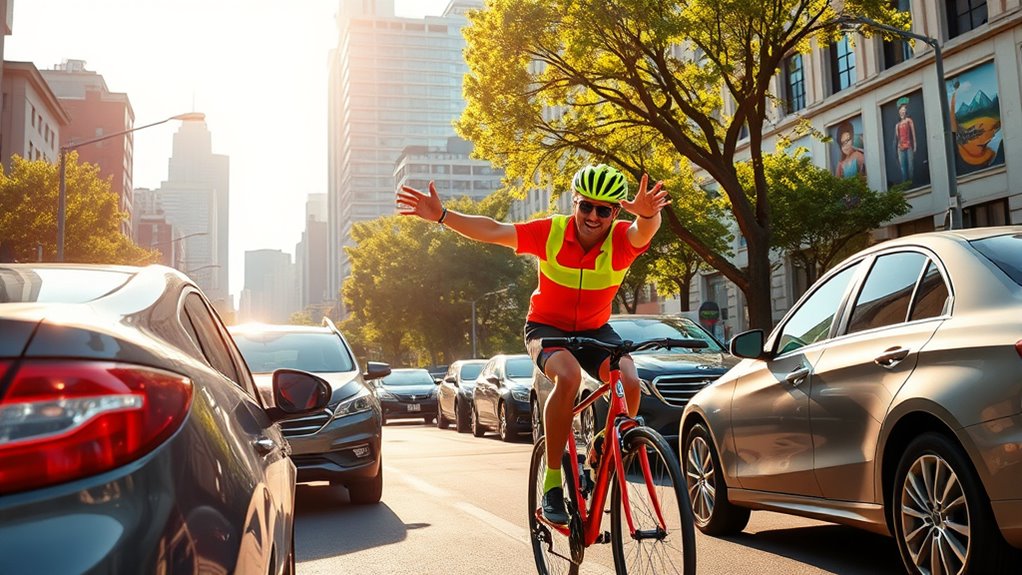
Being aware of your surroundings is essential when cycling in urban environments, as it directly impacts your safety and that of others.
Awareness of your surroundings while cycling in urban areas is crucial for your safety and that of others.
Here are some key tips to enhance your road awareness and courtesy:
- Maintain a safe distance of at least three feet from parked cars to avoid dooring accidents.
- Anticipate hazards by watching the behavior of other road users, which helps you react promptly.
- Use hand signals to communicate your intentions clearly, reducing misunderstandings with motorists and pedestrians.
- Regularly check mirrors and look over your shoulder, especially at intersections, to stay aware of approaching vehicles.
Frequently Asked Questions
What Is the 75 Rule in Cycling?
The 75 Rule in cycling suggests you aim for a cadence of 75 revolutions per minute (RPM) during your rides.
This target helps you optimize efficiency and reduce fatigue, allowing you to maintain a sustainable pace over longer distances. By focusing on this cadence, you’ll balance muscle engagement and cardiovascular effort, improving your performance, especially during climbs.
Consider using a bike computer or cadence sensor to help you stick to this benchmark effectively.
What Is the Rule 37 for Cycling?
Imagine riding a wave on your bike, skillfully maneuvering through the urban tide.
Rule 37 for cycling insists you keep at least one meter away from the curb. This distance helps you steer clear of hazards like parked cars and suddenly opening doors, keeping you safe and visible.
What Is the N-1 Rule for Bikes?
The N-1 rule for bikes states that for every bike you own, you should have one backup bike.
This way, you’re always ready to ride, even if your primary bike needs repairs. It encourages you to diversify your collection, catering to different riding styles and conditions.
Plus, having a spare bike means you won’t be stuck with a flat tire or mechanical issue, ensuring you stay active and enjoy cycling without interruptions.
What Is the 5th Rule of Cycling?
You mightn’t think twice about your visibility while cycling, but it could save your life.
The 5th Rule of Cycling emphasizes staying visible to everyone around you. Wear bright clothing and use front and rear lights, especially in low light.
Position yourself predictably on the road and signal your intentions clearly.
Conclusion
With these urban cycling hacks in your toolkit, you’re ready to conquer the city streets like a pro. Remember, every ride’s a dance between you and the road—stay aware, stay safe, and ride with confidence. Whether you’re zipping through bike paths or steering through traffic, keep your wits about you and enjoy the journey. So grab your gear, hit the pedals, and let the urban landscape unfold before you. Adventure awaits just around the corner!




